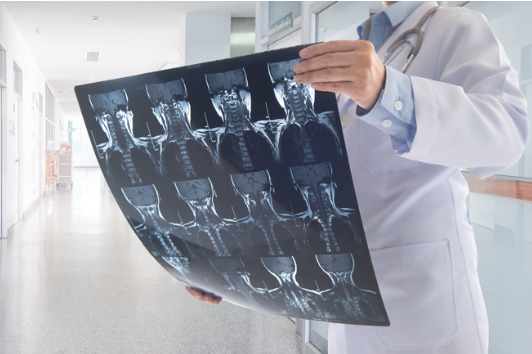Myelopathy
Understanding the Symptoms, Causes & Treatments for Myelopathy
Reviewed by: Dr. Christopher Good, Dr. Colin Haines, Dr. Ehsan Jazini
What is Myelopathy?
The spinal cord is the main pathway for information traveling from the brain to the peripheral nervous system. Myelopathy describes any neurologic symptoms related to the spinal cord as a result of spinal stenosis, a disc herniation, and bone spurs. Myelopathy is a very serious condition that if untreated can lead to significant and permanent nerve damage including paralysis and death.


What Are Common Symptoms of Myelopathy?
Symptoms may affect one’s gait and balance, fine motor skills including dexterity, grip strength, and bowel and bladder function. It can impinge nerve roots and cause radiculopathy to create pain, weakness, or sensory changes in either arms or legs. Positional sense of both arms and legs may be affected making it difficult to use your arms and hands and to know where you are placing your feet as you walk.
Other Symptoms:
- You may notice your handwriting change.
- You may walk differently and have difficulty balancing, frequently stumbling or falling.
- You may drop items and have difficulty performing fine motor tasks such as buttoning your clothes, clasping your jewelry or even typing.
- It can alter your bowel or bladder function; you may lose a sense of needing to urinate or be unable to hold your bladder and have incontinence.
Any of these symptoms are important to recognize and require urgent medical evaluation.
When Should You Seek Treatment for Myelopathy?
If you’re noticing symptoms associated with Myelopathy and suspect a spinal issue, it’s crucial to consider consulting a board-certified spinal specialist. Reach out promptly to a certified spine surgeon for an accurate diagnosis and timely treatment. Early intervention can significantly improve your overall well-being and provide a broader range of treatment options, which may decrease as symptoms persist. The key to a successful and speedy recovery lies in addressing the root of the pain with your spine specialist as soon as symptoms arise.
While many people experience day-to-day back or neck pain, dismissing it as soreness, this may not be the case for everyone. If your pain persists for more than 10 days, it should be taken more seriously. Evaluate such prolonged pain with a spine surgeon to identify the root issue and determine the appropriate treatment. Additionally, be attentive to other signs related to back or neck pain that should not be ignored, including pain accompanied by fever, pain associated with loss of bladder control, and weakness/tingling/numbness in your arms or legs.
It’s important to note that these are general guidelines based on our expertise in spine care over the past three decades, recognizing that each patient’s symptoms may be unique.


What are Common Causes of Myelopathy?
Causes of myelopathy include anything that compresses or injures the spinal cord. This could include a disc herniation, spinal stenosis (term for narrowed room around the spinal cord), bone spurs, or can even be caused by trauma.
How is Myelopathy Diagnosed?
During your initial consultation, a thorough medical history is obtained looking for symptoms such as difficulty with balance or dexterity which may indicate myelopathy. Also patients will undergo a comprehensive physical exam to evaluate for any abnormal exam findings such as hyper-reflexia which raises the clinical suspicion for myelopathy. Further diagnostic tests and imaging should be ordered if any abnormalities are found on exam or noted by the patient. These studies could include MRI scan, CT scan, myelogram, x-rays and possibly nerve testing (EMG).


What Are Common Treatments for Myelopathy?
Myelopathy is a serious condition that can cause permanent spinal cord injury and if left untreated can lead to significant and permanent nerve damage including paralysis and death. Surgical intervention is warranted in most cases of myelopathy. There are multiple different surgical approaches and procedures which exist to treat spinal stenosis. Each surgical plan is specific to the patient based on their spinal needs. All surgical plans share a common goal of relieving pressure on the spinal cord.

